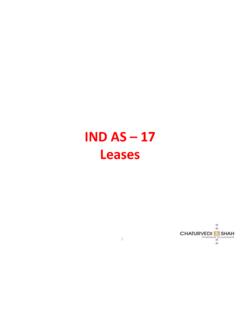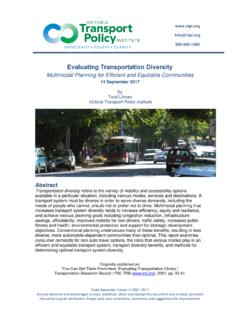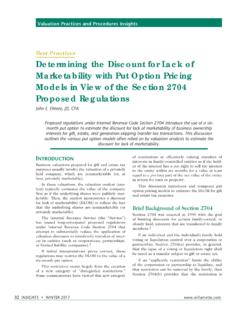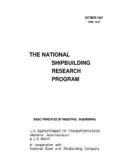Transcription of Valuation of Intangibles for Transfer Pricing …
1 1 Valuation of Intangibles for Transfer Pricing Purposes: Convergence of Valuations for Transfer Pricing Purposes with Valuation for Other Purposes Presentation to Working Party No. 6 of the Committee on Fiscal Affairs by: Dr. William F. Finan Susan Launiau March 23, 2011 * * * Context Our presentation is made in the following context: We discuss valuations performed for TP purposes relative to valuations performed for other purposes where we define other purposes to principally refer to valuations performed for accounting standards purposes (either IFRS or US GAAP, hereafter we will only reference IFRS).1 We will focus our remarks on the application of the income method of Valuation or the Discounted Cash Flow ( DCF ) approach since experience suggests that this is the most widely relied upon approach applied in performing TP valuations and is also frequently one of the methods relied upon in performing IFRS-related valuations.
2 Is there really a full convergence of TP and other valuations? Despite the fact that the title of this session suggests there may be a convergence between valuations done for TP purposes and those done for IFRS purposes, we think the situation is more nuanced. While there can be a convergence in some circumstances, more often than not there will be a material difference. Comparing the fair value standard under IFRS 3 ( (t)he amount for which an asset could be exchanged or a liability settled, between knowledgeable willing parties in an arm s length transactions ) with the arm s length standard as defined under the TPG, we believe it is reasonable to conclude that the two standards are very consistent, if not identical. Thus, the lack of convergence does not arise from any fundamental difference in the stated objectives of the TP and IFRS Valuation exercises.
3 Where the difference arise and why a Valuation performed for TP purposes does not necessarily always converge to a Valuation performed for IFRS purposes is due to differences in the way the DCF method is applied in performing a TP Valuation , particularly differences in the definition of key parameters applied in the analysis. Thus, DCF valuations performed for TP purposes may provide little information for the determination of the fair value of the Intangibles assets involved in the inter-company transactions for balance sheet purposes considering the accounting standards. Meanwhile, some Valuation methods frequently relied upon for accounting standards and corporate finance purposes cannot be reliably applied for Transfer Pricing purposes.
4 Why TP and IFRS valuations do not necessarily converge (1) the TP side Some of the more important reasons TP Valuation results and IFRS Valuation results do not necessarily converge are the following: 1 There is increasing converge between IFRS and US GAAP. 2/8 First, Transfer Pricing valuations frequently involve transactions for unique Intangibles that would not be transacted between unrelated parties. Entity A sells a unique and valuable bundle of rights and/or know-how to Entity B under circumstances where no unrelated party would likely be given the same access to the same grouping of rights and/or know-how. This uniqueness of the transactions engaged in on an inter-company basis frequently translates into relying upon the DCF as the most reliable method to apply under the TPG.
5 Market comparables simply do not exist for the same set of Intangibles nor would a cost approach (cost to replicate) be reliable. Second, the TPG recognizes at paragraph that there may be valuable Intangibles that are transacted inter-company even though they may have no book value in the company s balance sheet. This is important in the context of recognizing that TP valuations of Intangibles and corporate finance valuations which seek to value intangible assets for balance sheet purposes do not necessarily define the same type and grouping of intangible assets to be valued. Third, TP valuations frequently involve closely linked transactions that cannot be considered separately in performing a Valuation for TP purposes.
6 This point ties to applying TPG paragraph regarding evaluating transactions that are so closely linked that they cannot be evaluated adequately on a separate basis. This circumstance frequently creates a distinctive analytical framework for TP valuations. Fourth, adding to the guidance of paragraph , the TPG indicates that a transaction must be considered in its entirety to determine if the condition stated at paragraph is to be met2 that is, the TPG seeks to compare the as is situation to the other option or options available. Would Company A enter into the deal with Company B this can only be determined by considering all of the components of the transaction simultaneously or what paragraph of the TPG calls a package price.
7 This package price or bundling approach reflects a different philosophy from the one applied in performing IFRS valuations which seeks to identify the assets separately and value them separately. TP valuations consider the net result on a present value basis is A as the seller at least as well off or better off considering the transaction the package deal -- in its entirety? The package deal may need to include a balancing payment that is determined by the netting of the present values of the other closely linked transactions. The balancing payment would ensure that the package deal result complies with the guidance of paragraph the seller is at least as well off making the deal relative to the as is situation. The value of the balancing payment is more often than not different from the fair value of the Intangibles included into the package deal.
8 This is a one important distinction between TP valuations and those done for IFRS purposes. Fifth, TP valuations should be based on considering pre-tax income (typically operating income when it can be reliably determined) or cash (See Figure 1.) (This conclusion is supported from the TPG discussion of the proper application of the TNMM; for instance see Chapter II, paragraph reference to operating income). A comparison of the package deal results pre- and post-deal for the seller of a bundle of intangible assets should consider its pre-tax operating income results independent from the degree of the seller s financial leverage (again like in the TNMM context) and tax position. That is, TP valuations do not necessarily need to consider either element directly in arriving at the arm s length Valuation .
9 On the other hand, an IFRS Valuation is commonly considered to be based on the present value (PV) of post-tax cash flows in this regard it seeks to determine the market value for the Intangibles possessed by an entity for balance sheet purposes considering both tax and financial leverage conditions of the owner of the Intangibles . 2 This condition also appears elsewhere in the TPG; to simplify we only mention this single reference. 3 Some practitioners rely upon determining the PV of post-tax cash flows and then gross up to the pre-tax level. 3/8 Sixth, TP valuations are rarely made to determine the going concern value. More often than not, a TP Valuation is done for a piece of a business (or set of identified Intangibles ) within a larger enterprise or legal entity.
10 (See Figure 2.) Nor do TP valuations need to necessarily separately value certain assets of the business which are commonly valued in IFRS/corporate finance valuations; for example, the value of the existing work force is often valued as a separate asset. There can be other adjustments performed in corporate finance valuations such as the price paid for control of a business, etc., that are not routinely considered in the case of TP valuations. Nor is the TP Valuation necessarily directly concerned with goodwill. The treatment of goodwill into the context of a TP Valuation will depend on the context that gives rise to the goodwill in the IFRS Valuation thus must be considered on a case-by-case basis. More commonly in the case of TP valuations, the value of the constituent pieces of the total business are often subsumed in a TP Valuation to the splitting of the overall results between ordinary (including routine Intangibles such as the value of the existing work force) and what the functional analysis of the business identifies to be the potentially high value, non-ordinary Intangibles .

















